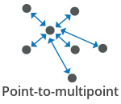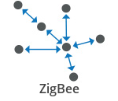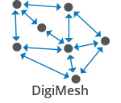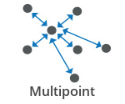Radio communication protocols
XBee modules support multiple wireless protocols which are suitable for many different network topologies. Open standards include Zigbee, 802.15.4, and Wi-Fi. Digi has also developed proprietary protocols such as Multipoint and DigiMesh. The following list includes the supported protocols:
IEEE 802.15.4
IEEE 802.15.4 is a standard which specifies the physical layer and media access control for low-rate wireless personal area networks. It is the basis for the Zigbee, ISA100.11a, WirelessHART, and MiWi specifications, each of which further extends the standard by developing the upper layers which are not defined in IEEE 802.15.4. The modules included in this kit are IEEE 802.15.4. The standard is designed specifically for energy efficient communications in a point-to-point or a point-to-multipoint configuration and includes sleeping and security.

|
Use:
|

|
Use:
|
Zigbee / Zigbee SE (Smart Energy)
Zigbee is a specification for a suite of high-level communication protocols. Its main purpose is to create a meshed network topology (hierarchy) to allow a number of devices to communicate among them.

|
Use:
|
DigiMesh (Digi proprietary)
DigiMesh is a proprietary peer-to-peer wireless networking protocol developed by Digi International Inc. DigiMesh forms a meshed network. The protocol allows for time-synchronized sleeping nodes/routers and low-power battery powered operation. The protocol is currently supported by several 900 MHz, 868 MHz, 865 MHz, and 2.4 GHz Digi radio modules.

|
Use:
|
Multipoint (Digi proprietary)
XBee multipoint RF modules are ideal for applications requiring low latency and predictable communication timing. They provide quick, robust communication in point-to-point, peer-to-peer, and multipoint/star configurations. Multipoint modules can be deployed as a pure cable replacement for simple serial communication or as part of a more complex hub-and-spoke network of sensors. Many DigiMesh XBee devices also support Multipoint as a transmit option.

|
Use:
|
IEEE 802.11 (Wi-Fi)
XBee Wi-Fi RF modules provide wireless connectivity to end-point devices in 802.11 bgn networks. Using the 802.11 feature set, these modules are interoperable with other 802.11 bgn devices, including devices from other vendors.
Use:
- Cloud-connected Wi-Fi products.
- Ideal for industrial applications that require fast time to market.
- Easily connect to a smartphone or tablet for configuration or data transfer.
Cellular
Cellular technology is ideal for wireless connectivity to end-point devices in remote locations or where signal penetration is an issue. Easily send data to AWS/MQTT or your own server application using TCP, UDP and SSL/TLS communication protocols.
Use:
- Cloud-connected cellular products.
- Ideal for remote applications that require fast time to market.
- Easily able to connect to AWS services.
Note Not all XBee devices can run all communication protocols. The combination of XBee hardware and radio firmware determines the protocol that an XBee device can execute. Refer to the Digi XBee Family Features Comparison for more information about the available XBee RF modules and the protocols they support.
 PDF
PDF


